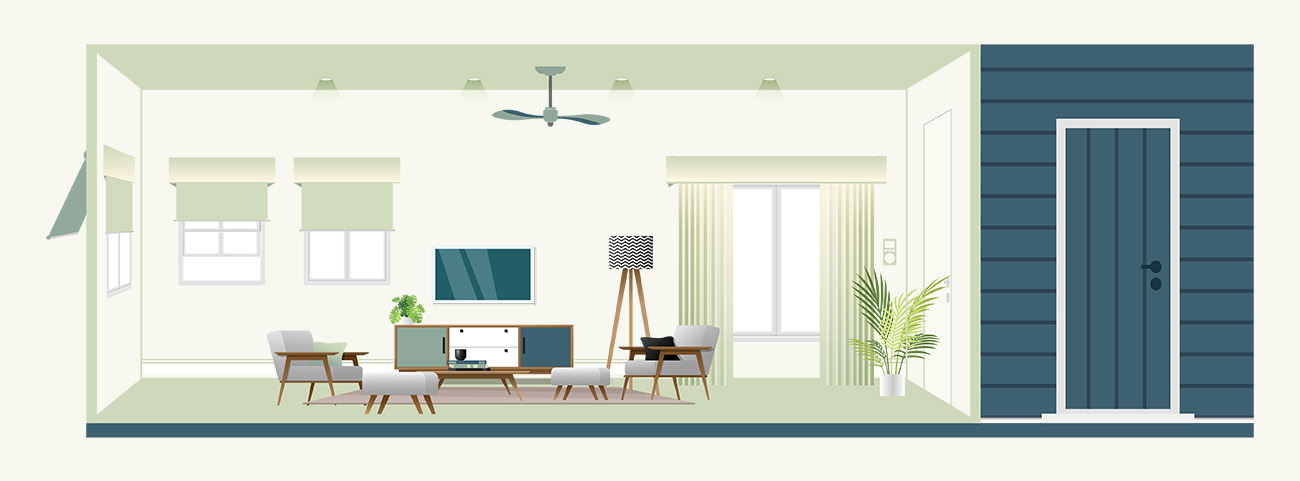Windows and Doors

 Draught sealing aluminium sliding doors & windows
Draught sealing aluminium sliding doors & windows Draught sealing aluminium sliding doors and windows
 Draught proofing for double hung (sash) windows
Draught proofing for double hung (sash) windows Draught proofing double hung (sash) windows
 Draught proofing front door
Draught proofing front door Draught proofing your front door
 Perimeter seal doors with EMV
Perimeter seal doors with EMV Perimeter sealing doors with EMV
 Glazing
Glazing Double glazing
Double glazing is far superior to single glazing in terms of thermal performance. If new double glazed windows are not an option, retrofit solutions are available too.
 Window frames
Window frames Window frames
Window and door frames have a big impact on thermal performance, with common aluminium frames performing relatively poorly. Thermally broken aluminium, timber or uPVC are much better choices as they conduct less heat.
 Pelmets
Pelmets Pelmets
Blinds and curtains must have pelmets fitted above them to prevent warm air reaching the window, creating a cold draught down the face of the window pane and lowering the indoor air temperature.
 Curtains & blinds
Curtains & blinds Curtains and blinds
Internal blinds and curtains can help prevent heat loss in winter and make your home much more comfortable.
Heavy thermally lined drapes provide the best insulation, particularly if they are floor length and fitted with a pelmet. Tight fitting blinds are a good choice too, in particular honeycomb blinds, roman blinds and to a lesser extent roller blinds.
 External shading
External shading External shading
External shading can prevent the sun from hitting your windows in summer, preventing unwanted heat gain. In the southern hemisphere this is particularly important for north, east and west facing windows, and different approaches may be needed depending on the window orientation. This can include external shutters and blinds, eaves, awnings, shade sails or covered pergolas.
In modern Australian homes, large windows and glazed doors allow for a connection with the outdoors and can let sunlight and warmth in to help with passive solar heating in winter.
However, windows can act like holes in your building’s envelope. According to Australian Government website Your Home, up to 40% of a home’s heating energy can be lost and up to 87% of its heat gained through windows.
Improving the thermal performance of your windows and doors can have a big impact on your home’s comfort and your energy usage for heating and cooling.
Draught proofing windows and doors
Windows and doors, particularly in older homes, are often quite draughty. Small gaps around the windows or doors can let air in or out, leading to unwanted heat loss in winter and heat gain in summer. Sealing these gaps can be done as DIY, or by hiring a professional draught-sealing specialist or handy-person.
Various types of rubber seals, storm seals and adhesives are readily available at hardware stores or from specialist suppliers. Check your seals before every winter to ensure they are still in good condition. Check out our videos below to get you started on your DIY draught proofing project.
Draught sealing aluminium sliding doors and windows
Draught proofing for double hung (sash) windows
Draught proofing your front door
Window and door glazing and frames
Most Australian homes have single glazed windows with aluminium or timber frames. Single glazed windows have limited insulating capacity, meaning heat energy is readily transferred through the glass, typically accounting for up to 40% of heat loss (winter) and up to 87% of heat gain (summer). Double (or triple) glazing is far superior in terms of thermal performance, and should always be considered when renovating or building new. Efficiency gains are increased with the addition of an inert gas like Argon between the panes.
Frames also have a big impact on window performance, with common aluminium frames performing relatively poorly. Thermally broken aluminium, timber or uPVC are much better choices as they conduct less heat.
Depending on the orientation of the window and your climate zone, you may also want to consider tints and glass coatings such as low-e glazing, which reduces the amount of radiant heat that can pass through the glass.
Existing windows can be replaced with double glazed windows. In many cases, the glass can be replaced with a double-glazed unit, retaining the existing frame.
However, this is not the only way to improve glazing performance. There are various retrofit double glazing solutions available, depending on your existing window design. Secondary glazing options include acrylic sheets that attach to the window frames, adding a second layer of glazing material and improving window performance at a much lower cost than a complete glass replacement. Both DIY solutions and products installed by a supplier are available.
Another solution that is commercially available is a window insulation shrink film which is applied to the inside of the window and then shrunk to size with a hairdryer. It is inexpensive and can provide good insulation.
For a temporary solution that may appeal to renters, you can fix bubble wrap to the inside of a window to improve its thermal performance significantly.
Retrofit double glazing
Further reading
Blinds, curtains and pelmets
Internal blinds and curtains can help prevent heat loss in winter and make your home much more comfortable, provided they are well designed and fit snugly around your windows.
Heavy thermally lined drapes provide the best insulation, particularly if they are floor length and fitted with a pelmet. Tight fitting blinds are a good choice too, in particular honeycomb blinds, roman blinds and to a lesser extent roller blinds. Some have multiple layers to improve thermal performance.
Blinds and curtains can effectively act like double glazing as they trap a layer of still air next to the glass. However, this is obviously most useful in the evening, not during the day when you want to let the sunlight in.
To provide effective thermal insulation, blinds should ideally be fitted within the window reveal. Otherwise blinds or curtains must have pelmets fitted above them to prevent warm air reaching the window, creating a cold draught down the face of the window pane and lowering the indoor air temperature.
Pelmets come in different designs and can be quite unobtrusive. There are even some temporary solutions available such as acrylic sheets (see video below) that can be inexpensively retrofitted and may particularly appeal to renters.
Further reading
External shading options
External shading can prevent the sun from hitting your windows in summer, preventing unwanted heat gain. In the southern hemisphere this is particularly important for north, east and west facing windows.
Depending on the window orientation, different approaches may be needed. North facing windows can be shaded with a fixed horizontal device, e.g. eaves, awnings, shade sails or covered pergolas. This will exclude the summer sun but allow the winter sun to still enter the house as it sits at a lower angle in the sky.
Pergolas can be covered with fixed or adjustable louvres, shade cloth, polycarbonate sheets, or by simply growing deciduous vines over them. Deciduous plants will block the hot summer sun, but after they lose their leaves, winter sun is welcomed into the building.
East and west facing windows may need a more flexible approach as the summer sun will sit at a lower angle in the mornings and afternoons, making it more difficult to block. External shutters or blinds may be more suitable here. These can be deployed when needed and are great at blocking the low-angle sunlight. A deep, covered pergola can also be a good solution.
Retractable awnings and adjustable louvre roofs are a flexible – but also pricier - option that allows sun and rain protection and can be opened and closed depending on the time of year and weather conditions.
